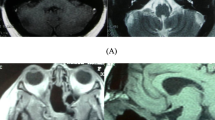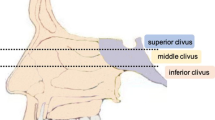Abstract
The aim of this study is to retrospectively analyze 161 cases of surgically treated skull base chordoma, so as to summarize the clinical classification of this tumor and the surgical approaches for its treatment via transnasal endoscopic surgery. Between August 2007 and October 2013, a total of 161 patients (92 males and 69 females) undergoing surgical treatment of skull base chordoma were evaluated with regard to the clinical classification, surgical approach, and surgical efficacy. The tumor was located in the midline region of the skull base in 134 cases, and in the midline and paramedian regions in 27 cases (extensive type). Resection was performed via the transnasal endoscopic approach in 124 cases (77 %), via the open cranial base approach in 11 cases (6.8 %), and via staged resection combined with the transnasal endoscopic approach and open cranial base approach in 26 cases (16.2 %). Total resection was achieved in 38 cases (23.6 %); subtotal resection, 86 cases (53.4 %); partial resection of 80–95 %, 29 cases (18 %); and partial resection <80 %, 8 cases (5 %). The clinical classification method used in this study seems suitable for selection of transnasal endoscopic surgical approach which may improve the resection degree and surgical efficacy of skull base chordoma. Gross total resection of skull base chordoma via endoscopic endonasal surgery (with addition of an open approach as needed) is a safe and viable alternative to the traditional open approach.









Similar content being viewed by others
References
al-Mefty O, Borba LA (1997) Skull base chordomas: a management challenge. J Neurosurg 86:182–189. doi:10.3171/jns.1997.86.2.0182
Cavallo LM, Prevedello DM, Solari D, Gardner PA, Esposito F, Snyderman CH, Carrau RL, Kassam AB, Cappabianca P (2009) Extended endoscopic endonasal transsphenoidal approach for residual or recurrent craniopharyngiomas. J Neurosurg 111:578–589. doi:10.3171/2009.2.JNS081026
Chibbaro S, Cornelius JF, Froelich S, Tigan L, Kehrli P, Debry C, Romano A, Herman P, George B, Bresson D (2014) Endoscopic endonasal approach in the management of skull base chordomas--clinical experience on a large series, technique, outcome, and pitfalls. Neurosurg Rev 37:217–224. doi:10.1007/s10143-013-0503-9, discussion 224–215
Chivukula S, Koutourousiou M, Snyderman CH, Fernandez-Miranda JC, Gardner PA, Tyler-Kabara EC (2013) Endoscopic endonasal skull base surgery in the pediatric population. J Neurosurg Pediatr 11:227–241. doi:10.3171/2012.10.PEDS12160
Couldwell WT, Weiss MH, Rabb C, Liu JK, Apfelbaum RI, Fukushima T (2004) Variations on the standard transsphenoidal approach to the sellar region, with emphasis on the extended approaches and parasellar approaches: surgical experience in 105 cases. Neurosurgery 55:539–547, discussion 547–550
de Divitiis E, Cavallo LM, Esposito F, Stella L, Messina A (2007) Extended endoscopic transsphenoidal approach for tuberculum sellae meningiomas. Neurosurgery 61:229–237. doi:10.1227/01.neu.0000303221.63016.f2, discussion 237–228
de Divitiis E, Esposito F, Cappabianca P, Cavallo LM, de Divitiis O, Esposito I (2008) Endoscopic transnasal resection of anterior cranial fossa meningiomas. Neurosurg Focus 25:E8. doi:10.3171/FOC.2008.25.12.E8
Fernandez-Miranda JC, Gardner PA, Snyderman CH, Devaney KO, Mendenhall WM, Suarez C, Rinaldo A, Ferlito A (2014) Clival chordomas: A pathological, surgical, and radiotherapeutic review. Head Neck 36:892–906. doi:10.1002/hed.23415
Fernandez-Miranda JC, Morera VA, Snyderman CH, Gardner P (2012) Endoscopic endonasal transclival approach to the jugular tubercle. Neurosurgery 71:146–158. doi:10.1227/NEU.0b013e3182438915, discussion 158–149
Fraser JF, Nyquist GG, Moore N, Anand VK, Schwartz TH (2010) Endoscopic endonasal transclival resection of chordomas: operative technique, clinical outcome, and review of the literature. J Neurosurg 112:1061–1069. doi:10.3171/2009.7.JNS081504
Gardner PA, Kassam AB, Thomas A, Snyderman CH, Carrau RL, Mintz AH, Prevedello DM (2008) Endoscopic endonasal resection of anterior cranial base meningiomas. Neurosurgery 63:36–52. doi:10.1227/01.NEU.0000335069.30319.1E, discussion 52–34
Gay E, Sekhar LN, Rubinstein E, Wright DC, Sen C, Janecka IP, Snyderman CH (1995) Chordomas and chondrosarcomas of the cranial base: results and follow-up of 60 patients. Neurosurgery 36:887–896, discussion 896–887
Holzmann D, Reisch R, Krayenbuhl N, Hug E, Bernays RL (2010) The transnasal transclival approach for clivus chordoma. Minim Invasive Neurosurg : MIN 53:211–217. doi:10.1055/s-0030-1267929
Ito E, Saito K, Okada T, Nagatani T, Nagasaka T (2010) Long-term control of clival chordoma with initial aggressive surgical resection and gamma knife radiosurgery for recurrence. Acta Neurochir 152:57–67. doi:10.1007/s00701-009-0535-7, discussion 67
Kassam A, Snyderman CH, Mintz A, Gardner P, Carrau RL (2005) Expanded endonasal approach: the rostrocaudal axis. Part I. Crista galli to the sella turcica. Neurosurg Focus 19(E3)
Kassam A, Snyderman CH, Mintz A, Gardner P, Carrau RL (2005) Expanded endonasal approach: the rostrocaudal axis. Part II. Posterior clinoids to the foramen magnum. Neurosurgical focus 19:E4
Kassam AB, Gardner PA, Snyderman CH, Carrau RL, Mintz AH, Prevedello DM (2008) Expanded endonasal approach, a fully endoscopic transnasal approach for the resection of midline suprasellar craniopharyngiomas: a new classification based on the infundibulum. J Neurosurg 108:715–728. doi:10.3171/JNS/2008/108/4/0715
Koutourousiou M, Gardner PA, Tormenti MJ, Henry SL, Stefko ST, Kassam AB, Fernandez-Miranda JC, Snyderman CH (2012) Endoscopic endonasal approach for resection of cranial base chordomas: outcomes and learning curve. Neurosurgery 71:614–624. doi:10.1227/NEU.0b013e31825ea3e0, discussion 624–615
Koutourousiou M, Snyderman CH, Fernandez-Miranda J, Gardner PA (2011) Skull base chordomas. Otolaryngol Clin N Am 44:1155–1171. doi:10.1016/j.otc.2011.06.002
Liu JK, Christiano LD, Patel SK, Tubbs RS, Eloy JA (2011) Surgical nuances for removal of olfactory groove meningiomas using the endoscopic endonasal transcribriform approach. Neurosurg Focus 30:E3. doi:10.3171/2011.2.FOCUS116
Menezes AH, Gantz BJ, Traynelis VC, McCulloch TM (1997) Cranial base chordomas. Clin Neurosurg 44:491–509
Messina A, Bruno MC, Decq P, Coste A, Cavallo LM, de Divittis E, Cappabianca P, Tschabitscher M (2007) Pure endoscopic endonasal odontoidectomy: anatomical study. Neurosurg Rev 30:189–194. doi:10.1007/s10143-007-0084-6, discussion 194
Saito K, Toda M, Tomita T, Ogawa K, Yoshida K (2012) Surgical results of an endoscopic endonasal approach for clival chordomas. Acta Neurochir 154:879–886. doi:10.1007/s00701-012-1317-1
Sekhar LN, Nanda A, Sen CN, Snyderman CN, Janecka IP (1992) The extended frontal approach to tumors of the anterior, middle, and posterior skull base. J Neurosurg 76:198–206. doi:10.3171/jns.1992.76.2.0198
Sekhar LN, Pranatartiharan R, Chanda A, Wright DC (2001) Chordomas and chondrosarcomas of the skull base: results and complications of surgical management. Neurosurg Focus 10:E2
Sen C, Triana AI, Berglind N, Godbold J, Shrivastava RK (2010) Clival chordomas: clinical management, results, and complications in 71 patients. J Neurosurg 113:1059–1071. doi:10.3171/2009.9.JNS08596
Stippler M, Gardner PA, Snyderman CH, Carrau RL, Prevedello DM, Kassam AB (2009) Endoscopic endonasal approach for clival chordomas. Neurosurgery 64:268–277. doi:10.1227/01.NEU.0000338071.01241.E2, discussion 277–268
Tan NC, Naidoo Y, Oue S, Alexander H, Robinson S, Wickremesekera A, Floreani S, Vrodos N, Santoreneos S, Ooi E, McDonald M, Wormald PJ (2012) Endoscopic surgery of skull base chordomas. J Neurol Surg Part B, Skull Base 73:379–386. doi:10.1055/s-0032-1321508
Thodou E, Kontogeorgos G, Scheithauer BW, Lekka I, Tzanis S, Mariatos P, Laws ER Jr (2000) Intrasellar chordomas mimicking pituitary adenoma. J Neurosurg 92:976–982. doi:10.3171/jns.2000.92.6.0976
Walcott BP, Nahed BV, Mohyeldin A, Coumans JV, Kahle KT, Ferreira MJ (2012) Chordoma: current concepts, management, and future directions. Lancet Oncol 13:e69–e76. doi:10.1016/S1470-2045(11)70337-0
Author information
Authors and Affiliations
Corresponding author
Additional information
Comments
Kiyoshi Saito, Fukushima, Japan
The authors nicely showed surgical results of 161 patients with clival chordomas. They proposed clinical classification of chordomas: midline group including anterior skull base, superior clivus, superior-middle clivus, middle-inferior clivus, inferior clivus and total clivus, and paramedian group. Different approaches were used for different types of chordomas according to the classification. Among 161 cases, transnasal endoscopic approach was selected in 124 and staged transnasal endoscopic and open cranial base approaches in 26. Surgical results such as degree of resection, clinical factors for inadequate resection, and complications were presented.
Since an extended endonasal endoscopic approach has been developed, most skull base chordomas could be removed using this approach. They divided endonasal endoscopic approaches into anterior skull base, superior clival, superior-middle clival, middle-inferior clival, inferior clival, and total clival approaches. The classification is simple and may facilitate the resection of main part of the tumor. However, for a long-term tumor control, total tumor resection with removal or drilling of the surrounding bone should be performed even in the endoscopic surgeries.
The authors have outstanding experience of endonasal endoscopic surgeries for clival chordomas, especially large and extended tumors. It is interesting to know how total clival, extensive, or paramedian chordomas were managed and what was the indication and limitation of staged or combined surgeries. Long-term outcome would elucidate the surgical efficacy of their classification.
Henry W. S. Schroeder, Greifswald, Germany
The authors present their experience of 161 patients undergoing surgical treatment of skull base chordomas and retrospectively evaluated their clinical classification, surgical approach, and surgical efficacy. The tumor resection was performed via a transnasal endoscopic approach in 124 cases (77 %), via an open cranial base approach in 11 cases (6.8 %), and via a combined transnasal endoscopic and transcranial approach in 26 cases (16.2 %). Total resection was achieved in 38 cases (23.6 %), subtotal resection in 86 cases (53.4 %), partial resection of 80–95 % in 29 cases (18 %), and partial resection <80 % in 8 cases (5 %). The authors conclude that the clinical classification used in their study seems to be suitable for the selection of a transnasal endoscopic surgical approach.
This is the largest surgical series of skullbase chordomas reported so far. I agree completely that the endonasal endoscopic approach is the most appropriate surgical access route for the majority of skull base chordomas because they arise usually from the clivus and all important neurovascular structure are lateral to the tumor center. The endoscopic approach provides direct access to the clival origin of the tumor and avoids unnecessary manipulations of the cranial nerves. Since the tumor consistency is usually soft, they can easily be removed by suction and curettage. Therefore, even intradural tumor parts can nicely be resected. Tumor parts which are not visible in straight line can be resected by using angulated endoscopes and instruments. All infiltrated bone of the skullbase has to be drilled to reduce the risk of recurrence. This can be elegantly done via the endonasal approach.
The authors propose the following chordoma classification: midline region types—(a) anterior skull base type, (b) superior clivus type, (c) superior-middle clivus type, (d) middle-inferior clivus type, (e) inferior clivus type, (f) total clivus type, and the extensive type (tumor in midline and paramedian region). In my opinion, this classification has little value in terms of approach selection and outcome. In all types except the last one, the endonasal approach is selected. The differentiation between endoscopic anterior skull base approach, endoscopic superior clival approach, endoscopic superior-middle clival approach, endoscopic middle-inferior clival approach, endoscopic inferior clival approach, and the endoscopic total clival approach has at best little clinical meaning. It is clear that the endonasal approach has to be extended according to the borders of the lesion. Additionally, it is clear that the rate of total resection depends on the size and extension of the lesion.
It is logic that in lesions which extend more laterally the endonasal approach is not sufficient and has to be combined with a transcranial approach. We start in most skullbase chordomas endonasally, and when we recognize that there is residual tumor which cannot be resected via this approach, we add a transcranial approach as a second stage. When the lesions is only laterally located, just a craniotomy is used.
The study nicely shows that total tumor resection is the most important prognostic factor. Sixty-four percent of the residual tumors had progression during the follow-up period. Furthermore, the limited effect of radiation is demonstrated. Nineteen patients among 37 cases (51 %) who had undergone postoperative radiotherapy had progression of the tumor.
Chordomas remain challenging lesion, but with the endoscopic endonasal approach, the resection rate can be improved and the morbidity reduced.
Rights and permissions
About this article
Cite this article
Gui, S., Zong, X., Wang, X. et al. Classification and surgical approaches for transnasal endoscopic skull base chordoma resection: a 6-year experience with 161 cases. Neurosurg Rev 39, 321–333 (2016). https://doi.org/10.1007/s10143-015-0696-1
Received:
Revised:
Accepted:
Published:
Issue Date:
DOI: https://doi.org/10.1007/s10143-015-0696-1




